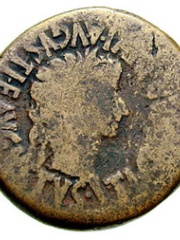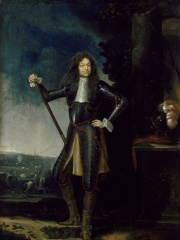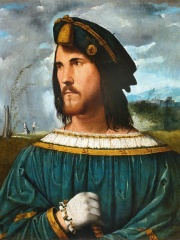
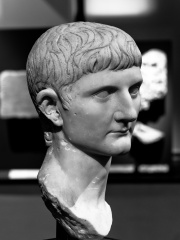
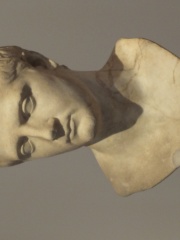
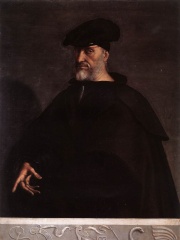
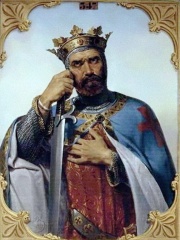
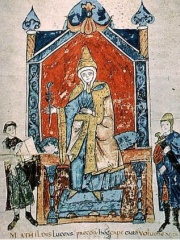
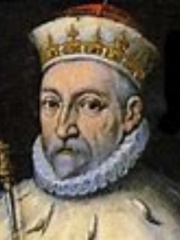
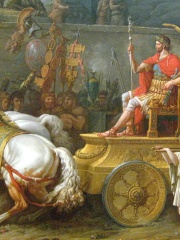
The Most Famous
MILITARY PERSONNELS from Italy
This page contains a list of the greatest Italian Military Personnels. The pantheon dataset contains 2,058 Military Personnels, 52 of which were born in Italy. This makes Italy the birth place of the 11th most number of Military Personnels behind Ukraine, and Greece.
Top 10
The following people are considered by Pantheon to be the top 10 most legendary Italian Military Personnels of all time. This list of famous Italian Military Personnels is sorted by HPI (Historical Popularity Index), a metric that aggregates information on a biography's online popularity. Visit the rankings page to view the entire list of Italian Military Personnels.

1. Cesare Borgia (1475 - 1507)
With an HPI of 80.49, Cesare Borgia is the most famous Italian Military Personnel. His biography has been translated into 53 different languages on wikipedia.
Cesare Borgia (13 September 1475 – 13 March 1507) was an Italian cardinal deacon and later a condottiero, as well as a member of the Spanish House of Borgia. He was the illegitimate son of Pope Alexander VI and sibling to Lucrezia Borgia. After initially entering the Church and becoming a cardinal on his father's election to the papacy, he resigned his diaconal profession after the death of his brother in 1498. He was employed as a condottiero for King Louis XII of France around 1500, and occupied both Milan and Naples during the Italian Wars. At the same time, he carved out a state for himself in Central Italy, but he was unable to retain power for long after his father's death. His quest for political power was a major inspiration for The Prince by the renowned Florentine historian, Niccolò Machiavelli.

2. Germanicus (15 BC - 19)
With an HPI of 77.73, Germanicus is the 2nd most famous Italian Military Personnel. His biography has been translated into 57 different languages.
Germanicus Julius Caesar (24 May 15 BC – 10 October AD 19) was a Roman general and politician most famously known for his campaigns against Arminius in Germania. The son of Nero Claudius Drusus and Antonia the Younger, Germanicus was born into an influential branch of the patrician gens Claudia. The agnomen Germanicus was added to his full name in 9 BC when it was posthumously awarded to his father in honor of his victories in Germania. In AD 4 he was adopted by his paternal uncle Tiberius, himself the stepson and heir of Germanicus' great-uncle Augustus; ten years later, Tiberius succeeded Augustus as Roman emperor. As a result of his adoption, Germanicus became an official member of the gens Julia, another prominent family, to which he was related on his mother's side. His connection to the Julii Caesares was further consolidated through a marriage between him and Agrippina the Elder, a granddaughter of Augustus. He was also the father of Caligula, the maternal grandfather of Nero, and the older brother of Claudius. During the reign of Augustus, Germanicus enjoyed an accelerated political career, entering the office of quaestor five years before the legal age in AD 7. He held that office until AD 9 where he was made praetor after the Pannonian war, and was elected consul for the first time in AD 12. The year after, he was made proconsul of Germania Inferior, Germania Superior, and all of Gaul. From there he commanded eight legions, about one-third of the entire Roman army at the time, which he led against the Germanic tribes in his campaigns from AD 14 to 16. He avenged the Roman Empire's defeat in the Teutoburg Forest and retrieved two of the three legionary eagles that had been lost during the battle. In AD 17, he returned to Rome, where he received a triumph before leaving to reorganize the provinces of Asia Minor, whereby he incorporated the provinces of Cappadocia and Commagene in AD 18. While in the eastern provinces, Germanicus came into conflict with the governor of Syria, Gnaeus Calpurnius Piso. During their feud, Germanicus became ill in Antioch and died on 10 October AD 19. His death has been attributed to poison by ancient sources, but that was never proven. As a famous general, he was widely popular and regarded as the ideal Roman long after his death. To the Roman people, Germanicus was the Roman equivalent of Alexander the Great due to the nature of his death at a young age, his virtuous character, his dashing physique, and his military renown.

3. Nero Claudius Drusus (38 BC - 9 BC)
With an HPI of 76.26, Nero Claudius Drusus is the 3rd most famous Italian Military Personnel. His biography has been translated into 48 different languages.
Nero Claudius Drusus Germanicus (38–9 BC), commonly known in English as Drusus the Elder, was a Roman general and politician. He was a patrician Claudian but his mother was from a plebeian family. He was the son of Livia Drusilla and the stepson of her second husband, the Emperor Augustus. He was also brother of the Emperor Tiberius; the father of the Emperor Claudius and general Germanicus; paternal grandfather of the Emperor Caligula, and maternal great-grandfather of the Emperor Nero. Drusus launched the first major Roman campaigns across the Rhine and began the conquest of Germania, becoming the first Roman general to reach the Weser and Elbe rivers. In 12 BC, he led a successful campaign into Germania, subjugating the Sicambri. Later that year he led a naval expedition against Germanic tribes along the North Sea coast, conquering the Batavi and the Frisii, and defeating the Chauci near the mouth of the Weser. In 11 BC, he conquered the Usipetes and the Marsi, extending Roman control to the Upper Weser. In 10 BC, he launched a campaign against the Chatti and the resurgent Sicambri, subjugating both. The following year, while serving as consul, he conquered the Mattiaci and defeated the Marcomanni and the Cherusci, the latter near the Elbe. His Germanic campaigns were cut short in the summer of 9 BC by his death after a riding accident. Drusus was a very able commander. His death slowed the northward expansion of the Roman Empire, and foreshadowed the disastrous Battle of the Teutoburg Forest. He was enormously popular among his men, who erected the Drususstein in his honor; his memory was elevated during the reign of his son Claudius. Drusus' accomplishments in battle were considerable. He fought numerous Germanic chiefs in single combat, and was likely the fourth and final Roman to achieve the spolia opima (for taking the armor and weapons of an enemy king after defeating him in single combat), though he died before he could be honored for it.

4. Andrea Doria (1466 - 1560)
With an HPI of 75.38, Andrea Doria is the 4th most famous Italian Military Personnel. His biography has been translated into 39 different languages.
Andrea Doria, Prince of Melfi (Italian: [anˈdrɛːa ˈdɔːrja]; Ligurian: Drîa Döia [ˈdɾiːa ˈdɔːja]; 30 November 1466 – 25 November 1560) was an Italian statesman, condottiero and admiral, who played a key role in the Republic of Genoa during his lifetime. Doria was considered the foremost naval leader in Europe at his time. From 1528, he served as Holy Roman Emperor Charles V's grand admiral in the Mediterranean, as well as his main shipbuilder along with Álvaro de Bazán the Elder, while also acting as a privateer with the ships he owned in order to increase his own wealth. Although he had mixed success against the eminent threat of the Ottoman admirals, his fleet helped secure the imperial naval lines between Spain and Italy. He also played a role in the development of amphibious warfare by the Spanish and Italian navies. As a citizen of Genoa, Doria used his relationship with Charles V to both protect the republic's independence and exercise a predominant influence in its councils. He refused official charges, accepting only the title of Father of the Fatherland, and instead ruled the republic as an economic and military player. Under his reforms, the Doge's office was reduced to two years instead of being elected for life, while plebeians were declared ineligible, and the appointment was entrusted to the members of the great and the little councils. His constitutional reforms would last until the end of the republic in 1797. His posterior historical reputation became influenced by the lens of his Venetian rivals, which accused him of unstrategic and duplicitous conduct in battle. Even then, several ships in the next centuries were named in his honour, the most famous being the Italian passenger liner SS Andrea Doria, launched in 1951, which sank following a collision in 1956.

5. Gaius Julius Caesar (135 BC - 85 BC)
With an HPI of 74.35, Gaius Julius Caesar is the 5th most famous Italian Military Personnel. His biography has been translated into 31 different languages.
Gaius Julius Caesar (; Latin: [ˈɡaːiʊs ˈjuːliʊs ˈkae̯sar]; c. 140 BC – 85 BC) was a Roman senator, a supporter of his brother-in-law, Gaius Marius, and the father of Roman statesman Julius Caesar.

6. Bohemond I of Antioch (1054 - 1111)
With an HPI of 73.89, Bohemond I of Antioch is the 6th most famous Italian Military Personnel. His biography has been translated into 50 different languages.
Bohemond I of Antioch (c. 1054 – 5 or 7 March 1111), also known as Bohemond of Taranto or Bohemond of Hauteville, was the prince of Taranto from 1089 to 1111 and the prince of Antioch from 1098 to 1111. He was a leader of the First Crusade, leading a contingent of Normans on the quest eastward. Knowledgeable about the Byzantine Empire through earlier campaigns with his father, he was the most experienced military leader of the crusade.

7. Matilda of Tuscany (1046 - 1115)
With an HPI of 73.40, Matilda of Tuscany is the 7th most famous Italian Military Personnel. Her biography has been translated into 43 different languages.
Matilda of Tuscany (Italian: Matilde di Toscana; Latin: Matilda or Mathilda; c. 1046 – 24 July 1115), or Matilda of Canossa (Italian: Matilde di Canossa [maˈtilde di kaˈnɔssa]), also referred to as la Gran Contessa ("the Great Countess"), was a member of the House of Canossa (also known as the Attonids) in the second half of the eleventh century. Matilda was one of the most important governing figures of the Italian Middle Ages. She reigned in a time of constant battles, political intrigues, and excommunications by the Church. She ruled as a feudal margravine and, as a relative of the imperial Salian dynasty, she brokered a settlement in the so-called Investiture Controversy. In this extensive conflict with the emerging reform Papacy over the relationship between spiritual (sacerdotium) and secular (regnum) power, Pope Gregory VII dismissed and excommunicated the Holy Roman Emperor Henry IV (then King of the Romans) in 1076. At the same time, Matilda came into possession of a substantial territory that included present-day Lombardy, Emilia, Romagna, and Tuscany. She made the Canossa Castle, in the Apennines south west of Reggio Emilia, the centre of her domains. After his famous penitential walk in front of Canossa Castle in January 1077, Henry IV was accepted back into the Church by the Pope. However, the understanding between the Emperor and the Pope was short-lived. In the conflicts with Henry IV that arose a little later, from 1080, Matilda put all her military and material resources into the service of the Papacy. Her court became a refuge for many displaced persons during the turmoil of the investiture dispute and enjoyed a cultural boom. Even after the death of Pope Gregory VII in 1085, Matilda remained a vital pillar of the Reform Church. Between 1081 and 1098, grueling disputes with Henry IV meant Canossan rule was in crisis. The historical record is sparse for this time. A turning point resulted from Matilda forming a coalition with the southern German dukes, who opposed Henry IV. In 1097, Henry IV retreated past the Alps to the northern portion of the Holy Roman Empire, and a power vacuum developed in Italy. The struggle between regnum and sacerdotium changed the social and rulership structure of the Italian cities permanently, giving them space for emancipation from foreign rule and communal development. From autumn 1098, Matilda regained many of her lost domains. Until the end, she tried to bring the cities under her control. After 1098, she increasingly used the opportunities offered to her to consolidate her rule again. Since she was childless, in her final years, Matilda developed her legacy by focusing her donation activity on Polirone Abbey. The account of Donizo reports that between 6 and 11 May 1111, Matilda was crowned Imperial Vicar and Vice-Queen of Italy by Henry V at Bianello Castle (Quattro Castella, Reggio Emilia). With her death, the House of Canossa became extinct in 1115. Well into the thirteenth century, popes and emperors fought over what was called the Terre Matildiche ("Matildine domains") as their rich inheritance. The rule of Matilda and her influence became identified as a cultural epoch in Italy that found expression in the flowering of numerous artistic, musical, and literary designs and miracle stories and legends. Her legacy reached its apogee during the Counter-Reformation and the Baroque Period. Pope Urban VIII had Matilda's body transferred to Rome in 1630, where she was the first woman to be buried in Saint Peter's Basilica.

8. Giovanni Giustiniani (1418 - 1453)
With an HPI of 72.70, Giovanni Giustiniani is the 8th most famous Italian Military Personnel. His biography has been translated into 30 different languages.
Giovanni Giustiniani Longo (Greek: Ιωάννης Λόγγος Ιουστινιάνης, romanized: Iōánnēs Lóngos Ioustiniánēs; Latin: Iovianus Iustinianus Longus; 1418 – 1 June 1453) was a Genoese nobleman, mercenary captain, and defender of Constantinople during its siege in 1453. He was instrumental in its defense and commanded 700 men, as well as leading the land forces protecting the city.

9. Lucius Aemilius Paullus Macedonicus (229 BC - 160 BC)
With an HPI of 71.51, Lucius Aemilius Paullus Macedonicus is the 9th most famous Italian Military Personnel. His biography has been translated into 38 different languages.
Lucius Aemilius Paullus Macedonicus (c. 229 – 160 BC) was a consul of the Roman Republic, as well as a general, who conquered the kingdom of Macedonia during the Third Macedonian War.
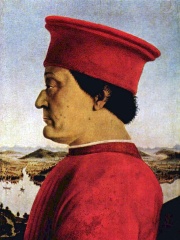
10. Federico da Montefeltro (1422 - 1482)
With an HPI of 70.86, Federico da Montefeltro is the 10th most famous Italian Military Personnel. His biography has been translated into 33 different languages.
Federico da Montefeltro, also known as Federico III da Montefeltro KG (7 June 1422 – 10 September 1482), was one of the most successful mercenary captains (condottieri) of the Italian Renaissance. He became the lord of Urbino in 1444, and ruled the city as its duke from 1474 until his death. In addition to his considerable reputation for martial skill and honour, he was a renowned intellectual humanist and civic leader. Montefeltro commissioned the construction of a great library, perhaps the largest of Italy after the Vatican's, complete with a team of scribes in its scriptorium. He also assembled a large humanistic court in his Ducal Palace, designed by Luciano Laurana and Francesco di Giorgio Martini.
People
Pantheon has 52 people classified as Italian military personnels born between 500 BC and 1920. Of these 52, none of them are still alive today. The most famous deceased Italian military personnels include Cesare Borgia, Germanicus, and Nero Claudius Drusus.
Deceased Italian Military Personnels
Go to all RankingsCesare Borgia
1475 - 1507
HPI: 80.49
Germanicus
15 BC - 19
HPI: 77.73
Nero Claudius Drusus
38 BC - 9 BC
HPI: 76.26
Andrea Doria
1466 - 1560
HPI: 75.38
Gaius Julius Caesar
135 BC - 85 BC
HPI: 74.35
Bohemond I of Antioch
1054 - 1111
HPI: 73.89
Matilda of Tuscany
1046 - 1115
HPI: 73.40
Giovanni Giustiniani
1418 - 1453
HPI: 72.70
Lucius Aemilius Paullus Macedonicus
229 BC - 160 BC
HPI: 71.51
Federico da Montefeltro
1422 - 1482
HPI: 70.86
Sejanus
20 BC - 31
HPI: 70.69
Raimondo Montecuccoli
1609 - 1680
HPI: 70.27
Overlapping Lives
Which Military Personnels were alive at the same time? This visualization shows the lifespans of the 22 most globally memorable Military Personnels since 1700.

